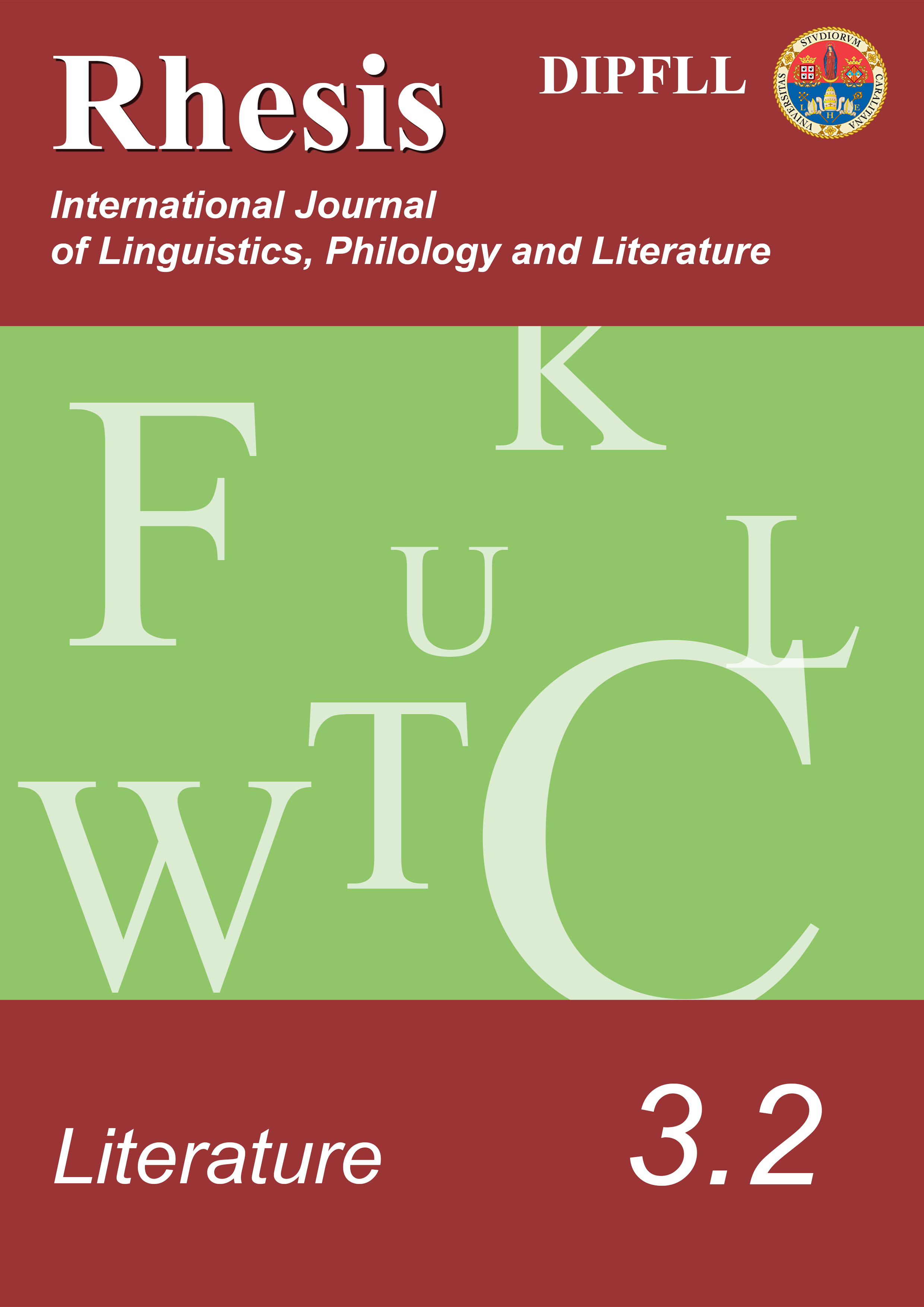Hunbaut: il percorso allegorico di un romanzo parodico
Abstract
The Arthurian romance Humbaut, composed in the late 13th century, is a fragmentary work handed down by a single manuscript, the well-known Chantilly, Musée Condé 472. In research conducted by previous scholars, Humbaut is compared to the other romances on Gauvain, which parodically deconstruct this famous Arthurian character. The aim of this article is to propose a new interpretation of this text. As a matter of fact, a more detailed analysis of the decisive episodes in the plot sheds new light on the relations between this romance and the Augustinian tradition, with special reference to De Magistro, which also focuses on the bond between teacher and pupil.
Downloads
References
(Sant’) Agostino, Il maestro, a cura di Massimo PARODI, Milano, Rizzoli, 1996.
(S.) Aurelii Augustini, De Diversis Quaestionibus Octoginta Tribus, in Opera Omnia, ed. latina, PL 40, LVII,
(S.) Aurelio Agostino, De Magistro, a cura di Mario CASOTTI, Brescia, La Scuola, 1951.
BUSBY, Keith, “Caractérisation par contraste dans le roman de Hunbaut”, «Studia Neophilologica», 52.2 (1980), pp. 415-24.
BUSBY, Keith, “Hunbaut and the Art of Medieval French Romance”, in Keith BUSBY, Norris J. LACY (eds.), Conjunctures: Medieval Studies in Honor of Douglas Kelly, Amsterdam, Rodopi, 1994, pp. 49-68.
BARATIN, Marc, DESBORDES, Françoise, Sémiologie et métalinguistique chez saint Augustin, «Langages», 16 (1982), pp. 75-89.
CASAGRANDE, Carla, VECCHIO, Silvana (eds.), Anima e corpo nella cultura medievale. Atti del V Convegno di studi della Società italiana per lo studio del pensiero medievale, Venezia, 25-28 settembre 1995, Firenze, SISMEL Edizioni del Galluzzo, 1999.
DORFLES, Gillo, Itinerario estetico. Simbolo mito metafora, Bologna, Compositori, 2011, pp. 217-218.
GREGORY, Tullio, Mundana sapientia. Forme di conoscenza nella cultura medioevale, Roma, Ed. di Storia e Letteratura, 1992, pp. 63-68.
GILSON, Étienne, La filosofia nel Medioevo: dalle origini patristiche alla fine del XIV secolo, presentazione di Mario Dal Pra, Firenze, Sansoni, 2004.
GINGRAS, Francis, “Décaper les vieux romans: voisinages corrosifs dans un manuscrit du XIIIe siècle (Chantilly, Condé 472)”, «Études françaises», 42.1 (2006), pp. 13-38.
GINGRAS, Francis, “(Chantilly, Condé 472)”, «Revue des langues romanes», 110.1 (2006), pp. 77-93.
Hieronymus, Divina Biblioteca 18. Liber Masloth Qui Dicitur Liber Proverbiorum, in Documenta Catholica Omnia (Excerpta ex MIGNE, Patrologia Latina)
HUNT, Tony, Miraculous Rhymes: The Writing of Gautier De Coinci, Cambridge, DS Brewer, 2007.
JOHNSTON, Roland Carlyle, OWEN, Douglas David Roy (eds.), Two Old French Gauvain Romances, Edinburgh-London, Scottish Academic Press, 1972.
JUNG, Marc-René, Études sur le poème allégorique en France au Moyen âge, Berne, A. Francke S. A., 1971.
LACY, Norris J., “The Character of Gauvain in Hunbaut”, «Bulletin Bibliographique de la Société Internationale Arthurienne», 38 (1986), pp. 298-305.
MICHA, Alexandre (ed.), Lancelot: Roman en prose du XIIIe siècle, 9 vols., Genève, Droz, 1978.
PARODI, Massimo, Il paradigma filosofico agostiniano. Un modello di razionalità e la sua crisi nel XII secolo, Bergamo, Lubrina Editore, 2006.
Raoul de Houdenc, Meraugis de Portlesguez. Roman arthurien du XIIIe siècle, publié d'après le manuscrit de la Bibliothèque du Vatican, ed. Michelle SZKILNIK, Paris, Champion, 2004.
SCHMOLKE-HASSELMANN, Beate, The Evolution of Arhurian Romance. The Verse Tradition from Chrétien to Froissart, New York, Cambridge University Press, 1998.
SCIUTO, Italo, Dire l’indicibile. Comprensione e situazione in S. Agostino, Padova, Francisci, 1984.
SZKILNIK, Michelle, “Le Chevalier oublieux dans quelques romans en vers du XIIIe siècle", in Patrizia ROMAGNOLI, Barbara WAHLEN (eds.), Figures de l'Oubli (IVe -XVIe siècle), «Études de Lettres», 1-2 (2007), pp. 77-95.
SZKILNIK, Michelle, “Un exercice de style au XIIIe siècle: Hunbaut”, «Romance Philology», 54 (2000), pp. 29-42.
THOMPSON, Raymond, “The Perils of Good Advice: The Effect of Wise Counsellor upon the Conduct of Gawain”, «Folklore», 90.1 (1979), pp. 71-76.
VIRDIS, Maurizio, Gloser la lettre, Roma, Bulzoni, 2001.
VIRDIS, Maurizio, “Percorsi e modi del tardo romanzo cortese”, «Critica del testo», 8.2 (2005), pp. 629-642.
WALTERS, Lori J., “Chantilly Ms. 472 as a cyclic work”, in Bart BESAMUSCA, Willem P. GERRITSEN, Corry HOGETOORN, Orlanda S. H. LIE (eds.), Cyclification: The Development of Narrative Cycles in the Chansons de Geste and the Arthurian Romances, Amsterdam, Royal Academy of Arts and Sciences, 1992, pp. 135-139.
WALTERS, Lori J., “The Formation of a Gauvain Cycle in Chantilly Manuscript 472”, «Neophilologus», 78 (1994), pp. 29-43, ripubblicato in Raymond H. THOMPSON, Keith BUSBY (eds.), Gawain. A Casebook, New York and London, Routledge, 2006, pp. 157-172.
WALTERS, Lori J., “Parody and Moral Allegory in Chantilly Ms. 472”, «Modern Language Notes», 113. 4 (September 1998), pp. 937-950.
WALTERS, Lori J., “De-membrer pour remembrer. L’oeuvre chrétienne dans le ms. Chantilly 472”, in Milena MIKHAÏLOVA (ed.), Mouvances et Jointures. Du manuscrit au texte médiéval, Orléans, Paradigme, 2005, pp. 253-281.
WILHELM, James J. (ed.), “Sir Gawain and the Green Knight.” The Romance of Arthur, New York, Garland Publishing, 1994.
WINTERS, Margaret (ed.), The Romance of Hunbaut: An Arthurian Poem of the Thirteenth Century, Leiden, Brill, 1984.
WOLEDGE, Brian, L'Atre périlleux: études sur les manuscrits, la langue et l'importance littéraire du poème, avec un spécimen du texte, Paris, E. Droz, 1930.
WOLEDGE, Brian (ed.), L’Atre périlleux, Paris, Champion, 1936.



